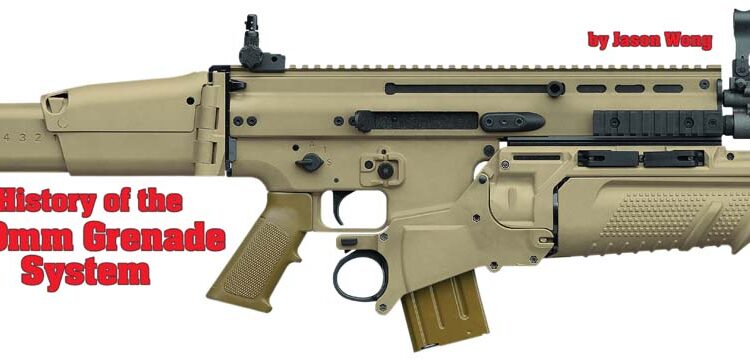By Jason Wong
The grenade launcher is ubiquitous within nearly all of the world’s armies, with nearly every military force fielding some type of grenade launching system. Western nations have traditionally developed and relied upon 40mm grenade systems, while Eastern Europe and the former Soviet empire rely upon 40mm caseless and 30mm systems. China reportedly relies upon a 35mm system. Given the likelihood that most readers are familiar with, and may have access to the 40mm system used by most western industrialized nations, this article attempts to describe the history of the 40mm grenade launcher from inception to the present.
The cartridge case grenade launching system is a relatively new concept, having first been developed within the 1960s. As the system has progressed and matured, the the 40mm grenade system of the 1960s has grown into several evolutionary branches. The heart of the system is a high-low pressure system that allows for launching heavier projectiles long distances at lower velocities than standard projectiles we would consider as “Bullets”. The two branches of the family used in US and NATO are the 40x46mm low velocity typified by shoulder fired launchers- the M79, HK69, M203, as well as today’s M320 and rotary drum MILKOR; and 40x53mm high velocity as used in the MK19 and HK GMG. From an analytical view, the 40x46mm grenade system can be described within four separate and distinct generations. Throughout the development of each generational system, breakthroughs have lead to other weapon systems, most notably, the 40x53mm high velocity grenade system. This article seeks to briefly describe the generational developments of the 40x46mm grenade system and its influence upon the modern infantryman.
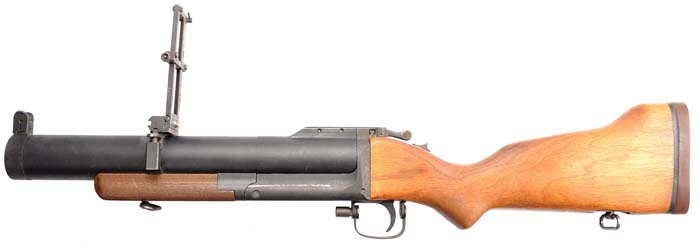
The idea of arming an infantryman with a weapon other than a rifle is not new. The grenade was first used in warfare in the 8th century by the Byzantine Empire. Comprised of clay or ceramic containers filled with an incendiary mixture, the earliest grenades were nothing like the modern explosive grenades. Nevertheless, the early Byzantine bombs were thrown by hand, with the intent to destroy a target – not unlike the desired effect of the modern grenade.
Explosive filled hand grenades reached a turning point during World War I, with the introduction of the British Mills bomb, and the use of more effective explosives. During the early 20th century, hand grenades came in a variety of shapes and sizes, ranging in shape of a discus, round baseball types, and stick grenades. While the U.S. Mk II “pineapple” grenade may be most easily identified and well known grenade of World War II, the term “grenade” is derived from the French word for “pomegranate,” with the idea that the Mills Bomb and other early hand grenades resembled the shape of a pomegranate fruit.
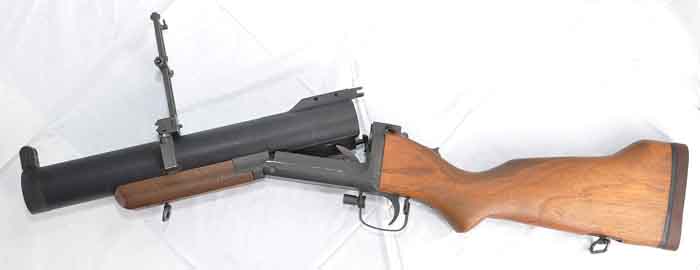
The ability for a soldier to throw an object is limited by the individual’s strength and dexterity. In most cases, physical limitations prevent a hand grenade from being thrown beyond 90 feet (30 meters). At the same time, military engineers and strategists realized the limitations of light mortars to engage targets within 350 feet of the firing point. The physical limitations of the soldier lead to the development of the rifle grenade. The rifle grenade permits the infantryman to mechanically launch an explosive projectile beyond an individual’s physical limitations and attempts to close the gap between the distance a hand held grenade may be thrown (90 feet) and the minimum safe distance of light mortars. By using a mechanical means to launch a rifle grenade, the entire battlefield could be effectively covered – hand thrown grenades in close combat, rifle grenades at intermediate distances, and light mortars at distances exceeding 350 yards. Attempts to address the issue can be seen in the World War II Japanese “knee mortar,” and the Italian Bixia 45mm crank operated “mortar” system. While both were effective in concept, both systems had their respective limitations. The Japanese knee mortar was effective on the battlefield, but the Japanese infantryman was still forced to carry the mortar tube and supporting ammunition. The Brixia system was even less effective, given that the maximum effective range of the Brixia was less than 90 feet, and well within the physical limitations of a hand thrown grenade.
Rifle grenades were employed as early as World War I, but the United States did not have a design of its own until 1941, with the introduction of the M1 system (for the 1903 Springfield rifle) and the M2 system (for the 1917 rifle). Efforts to launch grenades from the semiautomatic M1 Garand succeeded in 1943, with the introduction of the M7 system. Used with a specially manufactured blank cartridge, the semiautomatic feature of the rifle was temporarily disabled to allow all of the energy of the blank cartridge to be transferred into launching the rifle grenade. This system proved to be combat effective, but time consuming and potentially life threatening, given that the semiautomatic feature of the M1 Garand was disabled to fire the rifle grenade.
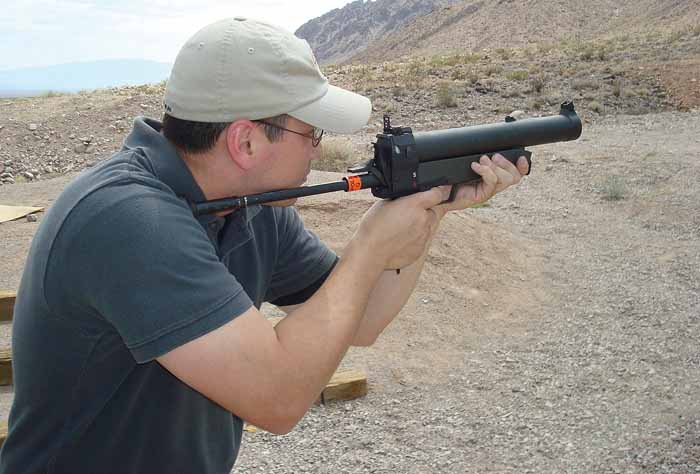
By the late 1950s, the need for a separate, standalone grenade launcher was recognized during development of the Special Purpose Individual Weapon (SPIW) project. The final requirements issued by the Army called for an over-under weapon with the ability to fire flechettes from one barrel, and grenades from the other. The weapons could weigh no more than 10 pounds (4.5 kg) fully loaded with three grenades and 60 flechette rounds. Three companies competed for the SPIW project, with Springfield Armory ultimately being awarded a contract to build a 40mm stand alone weapon that would ultimately be known as the M79.
Adopted in 1961, the M79 grenade launcher represents the first 40mm grenade launcher to be effectively adopted. Together with the Heckler and Koch HK69 grenade launcher, the two systems represent the first generation of 40mm grenade systems. Primarily made of steel, the units are intended as standalone units, and are not intended to be mounted to a secondary weapon. First generation 40mm systems are fully functional and effective for use as a primary weapon. Due in part to the technology and construction of the period, the units are single shot, break action-type weapons that tend to be heavy; the M79 weighs nearly 6.5 pounds (2.7 kg) loaded.
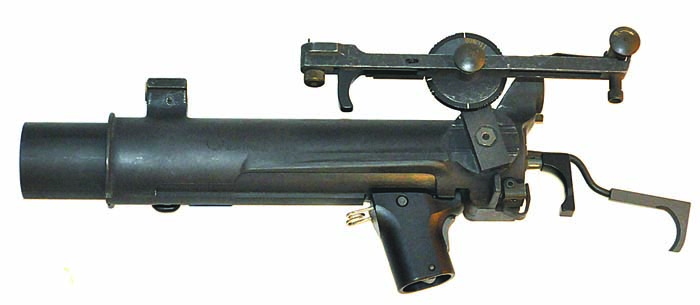
Birth of the Second Generation 40mm System: the XM148
Following adoption of the M79, it became evident that the 40mm grenade system was effective. Nevertheless, grenadiers were forced to make sacrifices in exchange for the ability to launch grenades at targets 350 meters away. The fuze within the 40x46mm grenade required 30 meters to arm; thus firing a 40mm grenade at a target closer than 30 meters was ineffective. Typically armed with a 1911 pistol as secondary weapon, grenadiers in Vietnam were also provided with the M576 40mm buckshot round and experimental flechette rounds of dubious effectiveness. The solution was the XM148, and the birth of the second generation of 40mm systems.
The second generation 40mm system can be classified as a dedicated weapon-mounted system, allowing the grenadier to carry a battle rifle, yet still have the ability to fire 40mm grenades. Typical second generation systems include the XM148, the M203, and the Heckler and Koch M79.
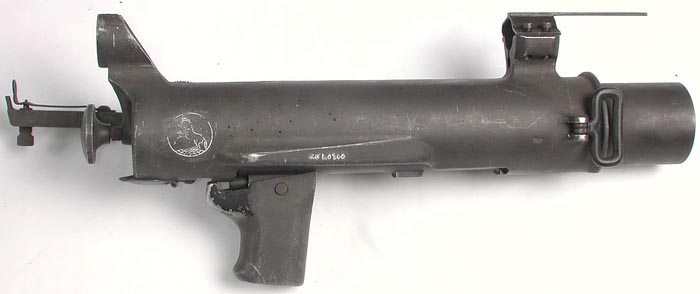
The M203 – the American Solution
Like a phoenix, the newly designed XM203 arose from the ashes of the failed XM148. In July 1967, the Army launched the Grenade Launcher Attachment Development (GLAD) program, with the intent to solicit interest in the development of an alternative grenade launcher to the XM148. Seven companies expressed interest, of which Philco-Ford, Aero Jet General, and Aircraft Armaments, Inc. (AAI) were awarded GLAD contracts. Each company proposed a different solution. Aero Jet submitted an SPIW-type semiautomatic launcher. Philco-Ford offered a brilliant design that featured a barrel that swung open to either side. AAI offered a single shot weapon with a pump action design. Surprisingly, Colt was absent from the competition, but had already delivered 27,400 XM148 units to the U.S. Department of Defense. Colt offered to redesign the XM148 into the CGL-5 at no cost, but was turned down by the U.S. Government. Drawings of the CGL-5 grenade launcher proposed by Colt can be seen in U.S. Patent 3507067. In addition, at least several prototype models were constructed, as examples are available in several weapon collections. The CGL-5 appears to be a reworked XM148 with similar features, including the tubular receiver and use of the pistol grip as a means to lock and unlock the breach. The firing mechanism appears to be simplified, as does the trigger mechanism. At its core however, the CGL-5 is an updated and modified version of the XM148.
In August 1968, the prototype submitted by AAI was selected and type-classified as the XM203. Authorization to build 600 XM203s was granted in December 1968, with orders that the units were to be assembled and sent to Vietnam for extended testing. AAI built and delivered the first 600 XM203 weapon systems, only to find that the company could not meet the production requirements proposed by the U.S. Government. In a cruel twist of fate, all future production contracts for the M203 were awarded to Colt.
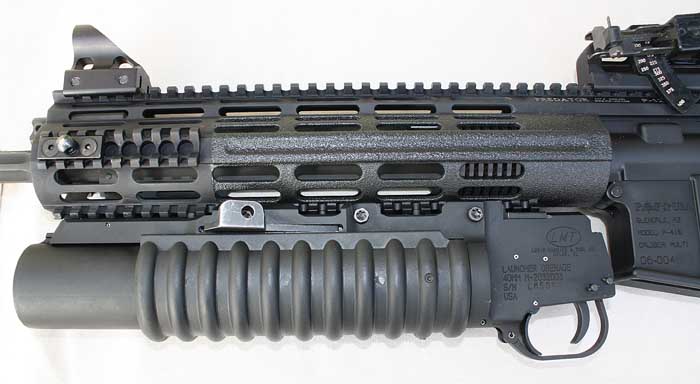
Similar in concept and basic design to the XM148, the M203 quickly became the de facto 40mm grenade launcher around the world. Adopted by at least 21 nations, the M203 has proven to be highly effective and capable in a variety of combat environments. Although designed by different designers and engineers, the influence of the XM148 can be seen within the simplified M203 system. As a second generation 40mm system, the M203 was originally designed to be mounted to the M16 rifle, with later variants of the M203 being modified for use with the M4 carbine, or as a standalone weapon. The M203 receiver eliminates the tube shaped receiver of the XM148, and instead relies upon on an extended bar shaped receiver, made of high strength forged aluminum alloy. Unlike the XM148 or HK69, the weapon features a self-cocking mechanism that operates when the barrel is locked into battery. For over 20-years, the M203 was the most commonly utilized grenade launcher within the western world.
Third Generation 40mm Systems: a Return to Basics
Second generation 40mm grenade launchers, namely the M203, dominated through the 80s and 90s until engineering developments introduced the third generation of 40mm systems. Third generation 40mm grenade launcher systems feature the development of a multifunctional dual use 40mm grenade launcher that is capable of functioning as a standalone unit or as a secondary part of an integrated system. In addition, improvements to manufacturing methods and materials benefitted the third generation systems through the increased use of aluminum, composites, and polymers. Examples of third generation 40mm systems include the Heckler and Koch AG-C, Heckler and Koch M320, the Colt Eagle, and the Fabrique Nationale EGLM systems.

Third generation systems generally rely upon a side opening breech, rather than the M203’s slide forward breech mechanism. In addition, most third generation 40mm systems are capable of accepting 40mm rounds longer than the original M433 HE round. Most third generation 40mm systems feature universal mounting solutions, dependent upon Mil-Std 1913 Picatinny rails as a mounting point, rather than relying upon specialized mounting hardware required to mount second generation systems to the host weapon. By presenting a universal mounting solution, the third generation 40mm system offers a unilateral cross-platform 40mm solution – that is, a single 40mm weapon system may be mounted on a host of primary weapons, without special tools in a quick and efficient manner. Mounting a third generation system to the host weapon typically requires the minimal use of common hand tools.
Unlike the M203, nearly all major firearm manufacturers feature a third generation system. With the near universal militarization of civilian police forces around the world, sales of 40mm systems have blossomed and manufacturers are no longer limited to selling 40mm systems solely to military units. Instead, the advent of 40mm less lethal rounds have placed 40mm systems within the hands of many police units for special situations and missions. An excellent example of a less lethal 40mm system can be observed via the Brugger & Thomet model GL-06 LL 40mm system. Although the system utilizes yellow furniture, rest assured that all types of standard 40x46mm ammunition will fit and function within the “less lethal” platform.
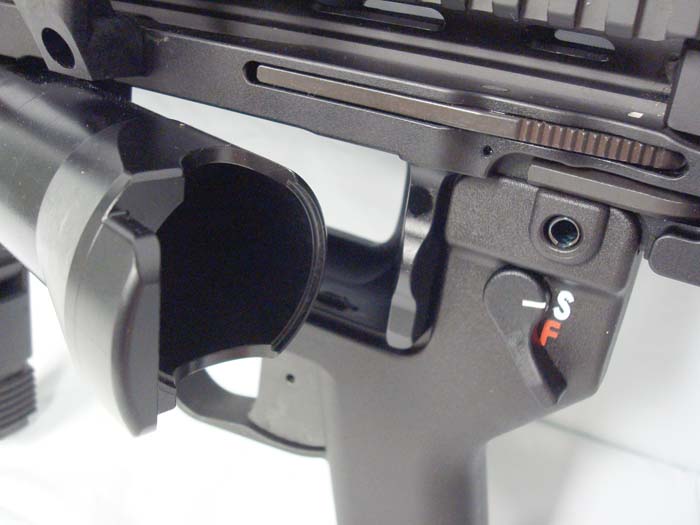
Fourth Generation: Multi-Shot Capability
While third generation systems are relatively new, are still undergoing development, and are still being reviewed for adoption by the world’s military forces, a concurrent generation of 40mm systems has been developed. While similar in construction materials and methods, fourth generation 40mm systems provide a light weight weapon system with multi-shot capability. The ability to fire multiple rounds without reloading is a feature never before seen in a mass produced 40mm system.
Avid historians are likely crying foul – the China Lake system with outward appearances to a pump shotgun on steroids – was developed in the 1960s. The China Lake system was comprised of a multi-shot system that allowed the user to fire four rounds: three rounds from the tubular magazine, and one round loaded in the chamber of the weapon. Nevertheless, the China Lake system was never widely adopted, and was never fielded in large numbers. In addition, the China Lake system was largely manufactured from steel and traditional manufacturing materials. Unlike the China lake system, the latest fourth generation launchers feature extensive use of polymer and composite materials in construction. Fourth generation systems also feature two independent characteristics as a means of permitting multiple launch capability: they either feature an ammunition drum or feed system, or feature multiple rounds loaded within a single barrel. An example of the first characteristic can be seen in the Milkor M32 system, which features a six-round rotary drum. The Milkor M32 system has been adopted by the U.S. Marine Corps, and U.S. Special Operations Command. Initial reports describe the M32 as a robust and mature system, capable of the use and abuse frequently seen in combat situations.
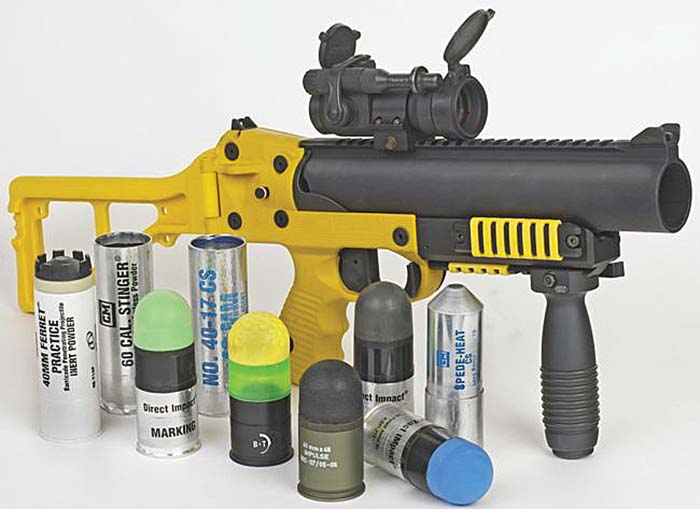
An example of the second characteristic can be observed in the Metal Storm system being developed by Chartered Industries of Singapore. The Chartered Industries system utilizes a seemingly traditional 40mm barrel, albeit loaded with three rounds of 40mm ammunition. The special barrel is reportedly disposable upon firing all three rounds, yet is engineered and designed to allow the user to fire a single round, two rounds, or all three rounds independently. To reload the system, the user replaces the spent barrel with a pre-loaded barrel. While the Chartered Industries system has been displayed at small arm trade shows, to date, there are no independent reports of fielding or use. Nevertheless, should the Charter Industries system be successfully fielded, the ability to fire three rounds from a single 40mm barrel should prove interesting.
The 40x53mm high velocity 40mm round was developed as an offshoot from its lowly 40x46mm low velocity brethren. Similarly, the divergence of low-velocity 40mm systems – namely, the use of single shot, weapon mounted platforms versus the use of multiple launch capability standalone systems may well prove to advance 40mm launchers into two separate and distinct types of 40mm grenade launchers.
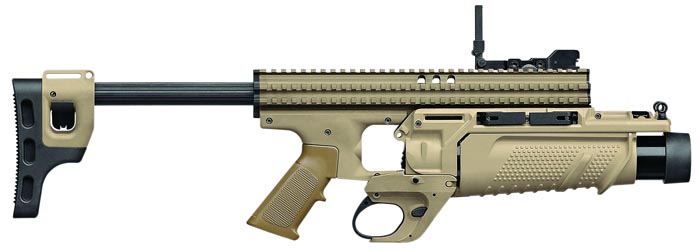
The Future
The 40mm grenade launcher has come a long way from its rifle grenade roots. Given developments in materials science and the use of composites, it is impossible to predict what the future may hold. The latest third generation systems that allow dual use as a stand-alone or a mounted system are likely to be adopted in wider numbers. Fourth generation systems like the Milkor M32 system are also likely to advance for specific roles and missions. Finally, advances in 40mm ammunition have provided grenadiers the ability to launch larger payloads over ever increasing distances. Given the divergence of third and fourth generation 40mm systems, it’s not inconceivable that a dedicated grenadier may reappear within the U.S. military doctrine. The widespread use of less lethal systems and the availability of a 40mm system from most major firearm manufacturers, it’s likely that increasing civilian law enforcement departments will be armed with 40x46mm systems. With the introduction of the medium velocity rounds, the shoulder fired range is extended to 800 meters. One certainty: the 40mm system will continue to remain relevant in the development of small arms.
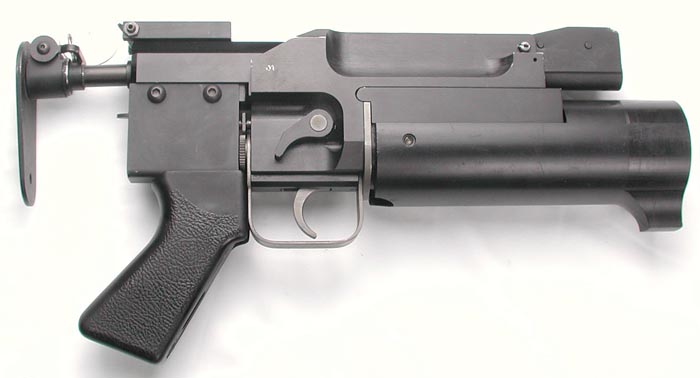
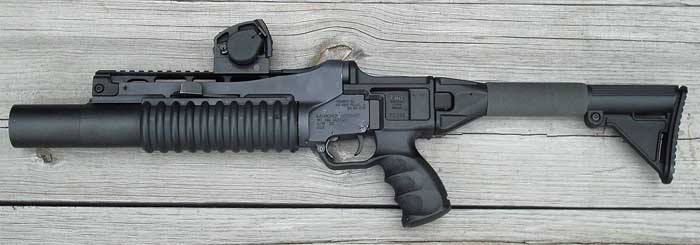
| This article first appeared in Small Arms Review V13N9 (June 2010) |



